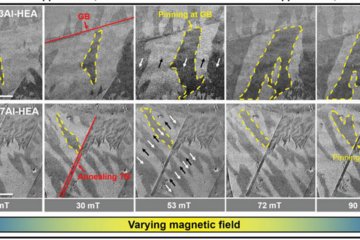All genres
901.
Thesis - PhD
Design of ZrCu thin film metallic glasses with tailored mechanical properties through control of composition and nanostructure. Dissertation, RUB Bochum, Bochum, Germany (2025)
902.
Thesis - PhD
Dislocation transmission through coherent and incoherent twin boundaries in copper at the micron scale. Dissertation, Ruhr University Bochum (2024)
903.
Thesis - PhD
Influence of plastic anisotropy on the deformation behaviour of Austenitic stainless-steel during single micro-asperity wear. Dissertation, Ruhr-Uiversität-Bochum (2023)
904.
Thesis - PhD
Hydrogen effects on the mechanical behaviour of FeCr alloys investigated by in-situ nanoindentation. Dissertation, Ruhr-Universität Bochum (2023)
905.
Thesis - PhD
Critical assessment and investigation of the Ti-Al-X (X = Si, Zr, O) systems. Dissertation, Ruhr-Universität Bochum (2023)
906.
Thesis - PhD
Phase identification and micromechanical characterization of an advanced high-strength low-alloy steel. Dissertation, Ruhr-Universität Bochum (2023)
907.
Thesis - PhD
Fundamental investigation of the atomic structures of [111] tilt grain boundaries, their defects and segregation behaviour in pure and alloyed Al. Dissertation, Ruhr-Universität Bochum (2023)
908.
Thesis - PhD
On the cementite behavior during tribology and experimental methods of microscale wear. Dissertation, Ruhr-Universität Bochum (2022)
909.
Thesis - PhD
Microstructure and grain boundary evolution in titanium thin films. Dissertation, Ruhr-Universität Bochum (2022)
910.
Thesis - PhD
Atomic-scale characterisation of grain boundary structure and segregation in bcc-iron. Dissertation, Ruhr-Universität Bochum (2022)
911.
Thesis - PhD
Development of combinatorial methods to tailor electrical and mechanical properties of Cu-based thin-film structures. Dissertation, Ruhr-Universität Bochum (2022)
912.
Thesis - PhD
Phase equilibria and phase transformations of Ti–Al–X (X=Nb, Mo, W) alloys for high-temperature structural applications between 700 and 1300 °C. Dissertation, Ruhr-Universität Bochum, Fakultät für Maschinenbau, Germany (2022)
913.
Thesis - PhD
Development of AlCrFeNiTi Compositionally Complex Alloys for High Temperature Structural Applications. Dissertation, Ruhr-Universität Bochum (2021)
914.
Thesis - PhD
On the damage initiation in dual phase steels: Quantitative insights from in situ micromechanics. Dissertation, Ruhr-Universität Bochum (2021)
915.
Thesis - PhD
Structure, chemistry and nanomechanics of grain boundaries in Cu–Ag alloys. Dissertation, Ruhr-Universität Bochum (2021)
916.
Thesis - PhD
Quantum mechanically guided design of mechanical properties and topology of metallic glasses. Dissertation, Fakultät für Georessourcen und Materialtechnik, RWTH Aachen (2020)
917.
Thesis - PhD
Probing dislocation nucleation in grains and at Ʃ3 twin boundaries of Cu alloys by nanoindentation. Dissertation, Ruhr-Universität Bochum (2020)
918.
Thesis - PhD
Development and application of a high-temperature micromechanics stage with a novel temperature measurement approach. Dissertation, Ruhr-Universität Bochum (2020)
919.
Thesis - PhD
Grain Boundary Structure, Phase Transitions and Segregation Phenomena in Copper Alloys. Dissertation, Ruhr-Universität Bochum (2019)
920.
Thesis - PhD
Mechanical properties of the cubic and hexagonal NbCo2 Laves phases studied by micromechanical testing. Dissertation, Ruhr-Universität Bochum (2019)











